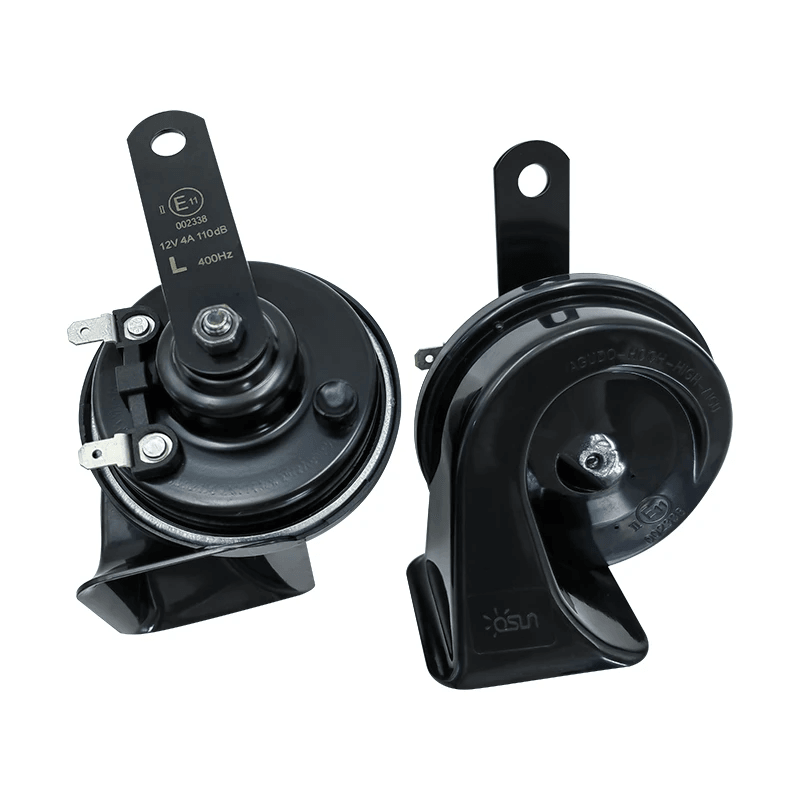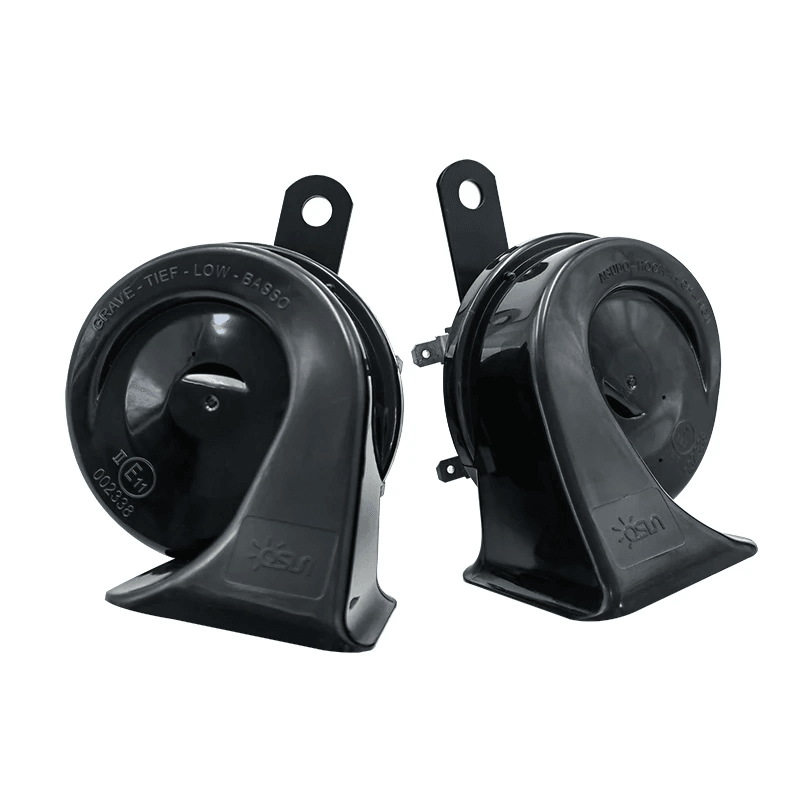Introduction
Discover the Unique Snail Horn
The snail horn is unlike any other vehicle horn, boasting a spiral shape that contributes to its unique acoustic properties. Its design allows for an impressive resonance that differentiates it from traditional air horns and train horns used in larger vehicles. As you delve deeper into the world of automotive horns, you'll find that the snail horn offers both aesthetic appeal and functional advantages.
Unraveling the Mystery of Snail Horn
So what exactly makes the snail horn tick? At first glance, it may seem just another car horn, but its engineering reveals much more beneath the surface. Understanding how this fascinating device works will unravel mysteries about sound production and frequency modulation—key elements in creating those memorable honks we associate with various vehicles.
The Importance of Snail Horn in Sound Production
In terms of sound production, the snail horn plays an essential role within automotive systems by delivering vibrant and attention-grabbing tones. Unlike standard air or train horns, which can be quite loud but lack character, the snail horn provides a melodic quality that enhances overall driving experience. As we explore its significance further along this journey, you'll appreciate why incorporating a snail horn into your vehicle can elevate not only safety but also style.
What is a Snail Horn?

When talking about vehicle horns, the snail horn stands out with its unique design and sound characteristics. This specialized automotive horn is known for its distinctive spiral shape, which gives it both aesthetic appeal and functional prowess. Unlike your typical car horn or even the robust air horn, the snail horn has a specific purpose that makes it an essential component in many vehicles.
Definition and Characteristics
A snail horn is defined by its coiled structure that resembles a snail's shell, hence the name. This unique shape allows for a more compact installation while still producing a loud and clear sound that can cut through traffic noise. Characteristically, snail horns are designed to emit a specific frequency range that makes them particularly effective in alerting pedestrians and other drivers on the road.
Differences from Other Horns
What sets the snail horn apart from other types of horns like air horns or train horns? For starters, while air horns deliver an explosive blast of sound often used in sporting events or emergencies, the snail horn provides a more melodic tone that is still attention-grabbing but less jarring. In comparison to train horns designed specifically for trains—often louder and deeper—the snail horn finds its niche within automotive applications where space and sound modulation are critical factors.
Common Uses in Various Vehicles
Snail horns have become increasingly popular in various vehicles ranging from cars to motorcycles due to their efficient design and appealing sound profile. You’ll often find them installed as standard equipment on certain models of cars or as aftermarket upgrades for enthusiasts seeking better auditory presence on the road. Their versatility also means they can be found on utility vehicles where clear communication is paramount—think delivery trucks needing to signal their approach without overwhelming nearby pedestrians with an overly harsh horn sound.
The Science Behind the Snail Horn Sound

When it comes to vehicle horns, the snail horn stands out not only for its unique shape but also for its remarkable sound properties. Understanding the science behind the snail horn sound reveals why it has become a popular choice for automotive enthusiasts. From acoustic properties to frequency ranges, these horns create a distinctive auditory experience that sets them apart from traditional car horns.
Acoustic Properties and Frequency Range
The acoustic properties of a snail horn are fascinating and contribute significantly to its effectiveness as a vehicle horn. Typically, snail horns produce sounds in a frequency range that is both attention-grabbing and pleasant to the ear, usually between 400 Hz and 1 kHz. This range allows the snail horn to cut through ambient noise more effectively than many other automotive horns, ensuring that drivers are heard in busy urban environments.
Moreover, the design of the snail horn enhances sound projection. Its spiral structure allows for better resonance and amplification of sound waves, creating a rich tone that can be heard from considerable distances. This characteristic makes it an ideal choice for those looking to upgrade their car horn or enhance their vehicle's auditory presence on the road.
Comparison with Air Horn and Train Horn Sounds
When comparing the sounds produced by different types of automotive horns, such as air horns and train horns, it's clear that each has its own unique signature. Air horns typically generate a loud blast that can be startling but lacks the tonal quality of a well-designed snail horn. On the other hand, train horns produce deep, resonant blasts designed for long-distance signaling; however, they may not always be suitable for everyday driving situations.
In contrast, the sound produced by a snail horn strikes an excellent balance between volume and tone quality—making it both effective and pleasant without being overwhelming. While air horns might grab immediate attention with their sheer loudness, they often lack the melodious quality that characterizes many high-end snail horns. Thus, choosing a snail horn can provide drivers with an ideal combination of sound clarity and intensity while enhancing their overall driving experience.
How Snail Horn Contributes to Automotive Sounds
The contribution of snail horns to automotive sounds goes beyond mere noise-making; they play an essential role in how vehicles communicate on roads today. These innovative vehicle horns not only serve as alerts but also add personality to cars through their distinctive tones—something that standard car or air horns often fail to achieve. By incorporating high-quality materials and advanced engineering techniques into their design, manufacturers have ensured that these automotive horns deliver reliable performance over time.
Furthermore, integrating snail horns into modern vehicles aligns with trends toward customization in automotive design—where drivers seek unique features that reflect their style preferences. The versatility of these snails means they can easily fit into various models while providing superior sound quality compared to traditional options like train or air horns used in heavy-duty applications or larger vehicles only occasionally found on roads today.
In summary, understanding how a snail horn operates scientifically showcases its advantages over conventional options available on today's market; this knowledge empowers consumers when making informed decisions about upgrading their vehicle's auditory capabilities.
Snail Horn in Automotive History

The evolution of vehicle horns has been a fascinating journey, marked by technological advancements and changing consumer preferences. Initially, horns were simple mechanical devices that produced sound through a basic diaphragm mechanism. Over time, the introduction of electric systems gave rise to more sophisticated options like the snail horn, which quickly became popular for its distinctive sound and reliability.
Evolution of Vehicle Horns
Vehicle horns have come a long way since their inception in the late 19th century. Early models often relied on hand-cranked mechanisms or air pressure to produce sounds that could barely be heard above the din of early engines. The introduction of electric horns revolutionized automotive sound production, paving the way for varied options like snail horns, air horns, and even train horns for larger vehicles.
As automotive technology progressed, so did the designs of vehicle horns. The snail horn emerged as a unique option that combined efficiency with a pleasing tone, distinguishing itself from traditional car horn sounds and louder air or train horn alternatives. Today’s vehicles often feature multiple types of horns to cater to different needs—whether it's a subtle beep or an assertive blast.
Notable Brands Incorporating Snail Horns
Several notable brands have recognized the charm and effectiveness of snail horns in their vehicle designs. Companies like Bosch and Hella have integrated these innovative horns into various models, enhancing both safety and aesthetic appeal with their unique sound profile. This choice reflects not only functionality but also an understanding of consumer preferences for distinctive automotive sounds.
Moreover, manufacturers such as Toyota and Ford have included snail horn designs in select models to offer drivers a blend of traditional car horn functionality with modern flair. These brands appreciate that while some may prefer loud air or train horn sounds for attention-grabbing purposes, others seek something more refined—enter the snail horn! This diversity in offerings helps cater to varying driver tastes across different markets.
Impact on Modern Automotive Design
The impact of snail horns on modern automotive design cannot be overstated; they represent a perfect marriage between form and function within vehicle acoustics. As designers strive for innovation while maintaining safety standards, integrating unique sounding devices like snail horns has become essential in creating memorable driving experiences. In turn, this has influenced how consumers perceive vehicle quality based on auditory feedback during operation.
Furthermore, as environmental awareness grows among consumers, there is increasing demand for less intrusive yet effective warning systems—making the subtle yet distinct sound produced by snail horns an attractive option compared to louder air or train horn alternatives. This shift towards quieter yet effective solutions reflects broader trends in automotive design focused on sustainability without compromising performance or safety features.
In summary, as we look back at the evolution of vehicle horns—from basic mechanical devices to sophisticated electronic systems—the significance of innovations like the snail horn shines brightly within this narrative. Its incorporation by notable brands illustrates its value in contemporary automotive design while shaping future trends toward more personalized driving experiences.
Choosing the Right Snail Horn for Your Vehicle

When it comes to outfitting your vehicle with a snail horn, making the right choice can elevate your automotive experience significantly. A snail horn is not just about making noise; it's about finding the perfect blend of size and sound that suits your vehicle's personality. Whether you're replacing an old car horn or upgrading to something more powerful, understanding your options is crucial.
Factors to Consider: Size and Sound
The size of a snail horn can greatly influence its sound output and installation feasibility in your vehicle. Larger horns often produce deeper tones, which can be more attention-grabbing than smaller models, but they may also require more space under the hood. Additionally, consider the sound frequency; a higher-pitched snail horn might stand out in urban traffic, while a lower tone could resonate better on rural roads.
Sound quality is equally important when choosing a snail horn; after all, you want it to be distinct from standard air horns or even train horns for train enthusiasts. Pay attention to the decibel rating—this will give you an idea of how loud the horn sound will be once installed. Ultimately, balancing these factors ensures that you choose a snail horn that not only fits well but also sounds fantastic.
Popular Brands and Models
Several brands have made their mark in the world of automotive horns, particularly when it comes to snail horns. Companies like Hella and Fiamm offer reputable models known for their durability and distinctive sounds that can rival traditional air horns or even train horns for train lovers seeking something unique. For those looking for budget-friendly options without compromising quality, brands like Wolo provide excellent choices as well.
When selecting a model, look for user reviews that highlight both performance and ease of installation—these insights can save you time and frustration down the road. Popular models often come with various mounting options too; some are designed specifically for compact cars while others cater to larger vehicles like trucks or SUVs where space isn't as much of an issue.
Installation Tips for Automotive Horns
Installing a snail horn may seem daunting at first glance, but with some preparation and patience, it can become quite straightforward! Before getting started, gather all necessary tools such as wrenches and connectors; this will streamline your process significantly when working on automotive horns. Always consult your vehicle’s manual for specific instructions regarding wiring connections—getting this right ensures optimal performance.
Once you’ve removed the old car horn (if applicable), take note of where you’ll mount the new snail horn; positioning plays a key role in both aesthetics and functionality! Make sure it’s securely fastened to avoid any rattling during drives—a loose installation could lead to unwanted noise issues later on! Finally, after connecting everything correctly according to color codes (usually red for positive), give it a test honk before closing up shop—it’s always rewarding hearing that satisfying honk!
Xiamen Osun Electronic Technology Co., Ltd. and Snail Horns

Xiamen Osun Electronic Technology Co., Ltd. has carved a niche for itself in the automotive industry with its innovative snail horn designs. Specializing in high-quality vehicle horns, the company has become synonymous with reliability and performance. Their expertise in sound technology ensures that each snail horn delivers a distinct horn sound that resonates well with drivers seeking both safety and style.
Company Overview and Expertise
Founded with a vision to revolutionize automotive horns, Xiamen Osun has established itself as a leader in snail horn manufacturing. The team comprises passionate engineers and designers who understand the nuances of sound production, ensuring that every car horn they produce meets rigorous standards. With years of experience under their belt, they have built a reputation for delivering exceptional products that enhance the driving experience.
Innovations in Snail Horn Technology
Xiamen Osun is at the forefront of snail horn technology, constantly pushing the boundaries of what's possible in vehicle horns. They have integrated advanced acoustic engineering techniques to optimize sound frequency ranges, making their snail horns not just loud but also melodious compared to traditional air horns or train horns for trains. By focusing on innovation, they ensure that their products stand out in a competitive market where quality is paramount.
Commitment to Quality Standards in Manufacturing
Quality is non-negotiable at Xiamen Osun Electronic Technology Co., Ltd., where every snail horn undergoes stringent testing before it reaches consumers. Their commitment to excellence means utilizing top-grade materials and cutting-edge manufacturing processes, ensuring durability and optimal performance of automotive horns over time. This dedication not only enhances customer satisfaction but also solidifies their position as a trusted name among car enthusiasts looking for reliable car horns.
Conclusion
In the world of automotive horns, the snail horn stands out as a true game changer. Its unique design and sound production capabilities not only enhance vehicle safety but also add a touch of personality to any car. As we’ve explored, the snail horn combines functionality with style, making it a must-have for modern vehicles.
Why Snail Horn Is a Game Changer
The snail horn redefines what we expect from vehicle horns, offering a distinctive sound that sets it apart from traditional air horns and train horns. Its compact size and efficient design make it an ideal choice for various vehicles without compromising on performance or volume. Moreover, its ability to produce an impressive horn sound ensures that drivers can alert others effectively while cruising down the road.
Enhancing Your Vehicle with Snail Horns
Upgrading to a snail horn can significantly enhance your vehicle's auditory profile, providing not just noise but character. Unlike standard car horns that blend into the background, the unique tone of a snail horn grabs attention and expresses individuality. Whether you’re looking for something subtle or want to make a bold statement, there’s a snail horn that fits every driver’s needs.
Future Trends in Automotive Horn Technology
As automotive technology evolves, so too will the designs and functionalities of vehicle horns like the snail horn. We can expect innovations that improve sound quality while reducing energy consumption—essentially making these horns more eco-friendly than their air horn and train horn counterparts. Additionally, advancements in materials may lead to lighter yet more durable options, ensuring that future generations enjoy the benefits of this game-changing technology.
